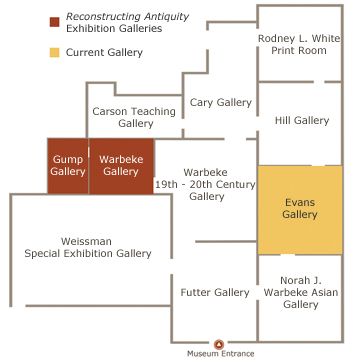Seated figures in a mourning ritual, possibly playing rattles
Learn more about the object below
In ancient Greece, the period from 900-700 BCE is often termed the Geometric Period after the popularity of geometric ornament in the art of that time. Painted pottery is the most common form of art to survive from this period, and among the most frequently used designs are meanders (the “Greek key” pattern), checkerboards, zigzags, and cross-hatched lozenges. Some scholars believe that rectilinear motifs, such as the designs on the example from the British Museum illustrated at right, are related to those used in woven patterns and embroidered designs on textiles. On the bowl from the Mount Holyoke collection, horizontal zones of checkerboards and vertical panels of cross-hatched bands and lozenges surround the figural scene.
Pots with scenes of humans and animals were prevalent in the Greek Late Bronze Age (ca. 1500-1100 BCE), but by the beginning of the Geometric period (ca. 900 BCE) abstract ornament alone was preferred. In the 8th century BCE, however, painters revived figural scenes and placed silhouetted men, women, animals, and chariots in small rectangular panels set within the network of geometric pattern. On this example, the row of seated figures emerges from the surrounding checkerboard bands. In later Greek art more elaborate narrative scenes dominated the decorated surface, and ornament was reduced to a strictly supporting role.
The shape of Mount Holyoke’s vessel, a high-rimmed, ribbon-handled bowl, was common only during the last few decades of the 8th century BCE (about 730-700 BCE). Its exceptionally tall and straight rim makes it unsuitable as an eating or drinking vessel, and it probably served instead as a container for jewelry or perfumed ointment, thus replacing the pyxis—a round box with a lid—that disappeared from the potter’s repertoire just as this new shape began to appear. Intact vessels, like this one, usually owe their survival to having been buried as grave gifts in tombs.
The interpretation of the seated figures holding oblong objects on Mount Holyoke’s vessel continues to puzzle scholars. The objects have been identified as rattles, clappers, distaffs, and pomegranate-shaped water sprinklers. A small number of Late Geometric vessels show a pair of seated figures with similar objects, and these also include a rectangular funerary bier. Some scholars suggest these scenes depict a funeral ritual involving music or noise-making. Others identify the “bier” as a table, and thus imagine a banqueting scene, perhaps also associated with funerary rites. The long row of several figures on this vessel is unique, however, and its meaning is still elusive.
Label texts by Pamela J. Russell, Ph. D., Andrew W. Mellon Coordinator of College Programs, Mead Art Museum, Amherst College.
Suggested reading:
Susan H. Langdon, ed., From Pasture to Polis: Art in the Age of Homer. Columbia: University of Missouri Press, 1993.





